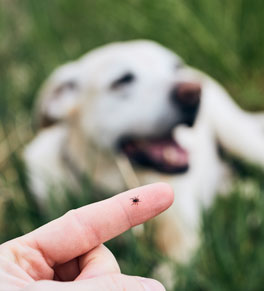Protect yourself from tick-borne infections

It's a good idea to check yourself and your pet for ticks after nature walks.
Each year across California, vacationers venture into wildland areas populated by deer and other animals harboring ticks that may transmit Lyme disease and other serious infections.
Encountering the black-legged ticks that carry Lyme disease is a greater concern on the East Coast and in the northernmost coastal areas of California.
But the Western black-legged tick also has been found in Southern California, where they thrive in cool, moist ravines, gullies and wetlands with plenty of vegetation, says Dr. Robert J. Katzer, associate director of Emergency Medical Services at UCI Health and an expert in wilderness medicine and rescue.
The state's tick population also is expected to surge this season, spurred by an unusually wet winter.
What’s my risk?
The risk for Lyme disease across most of California is low. With the exception of Sierra, Santa Cruz, Mendocino, Mariposa and Humboldt counties, the state reported fewer than two confirmed cases per 100,000 people from 2012 through 2021.
But other ticks commonly found in California also spread diseases, including Rocky Mountain spotted fever, Pacific Coast tick fever, anaplasmosis, babesiosis and tularemia, according to the state Department of Public Health.
The best defense against tick-borne illnesses is knowing where these tiny insects hang out, finding them on your body and removing them as soon as possible, says Katzer, a professor of emergency medicine at the UCI School of Medicine.
They usually position themselves at the tip of grasses, rushes or leaves and wait for an unsuspecting host to brush by.
“They can sense carbon dioxide from human breath, scent and heat,” he says. “They don’t fly or bounce, they simply release and grab on when the timing is right.”
Spotting ticks
Ticks, members of the arachnid family, feed on the blood of animals, including birds, rodents, deer and humans. They can be as tiny as poppy seeds or up to one-eighth of an inch long, depending on the species and their life stage.
They expand in size as they draw blood. In the process, infected ticks may leave behind small amounts of a virus or bacteria in their saliva, according to the U.S. Centers for Disease Control and Prevention.
Ticks are commonly found in areas with trees, shrubs, tall grass, rocks, logs and fallen leaves, and along trails. They also live in oak, pine and redwood forests.
In campgrounds and parks, ticks also have been found on picnic benches and wood logs, so be alert when sitting or resting while camping or hiking.
If you live near natural areas, you may also find them in your neighborhood and even your backyard.
Do a body check
If you spend time in areas with an abundance of moist vegetation, it’s important to be vigilant about ticks.
Whenever you return from an outdoor adventure, do a full-body check after a hot shower.
You’ll need help from a friend or family member to check your scalp and body thoroughly. It’s also a good idea to run your clothes through a hot wash and high-heat dryer cycle to kill any remaining ticks, which are susceptible to heat.
If you find one, remove it carefully as soon as possible.
Katzer says it is generally thought that if you remove a tick within 24 hours, it has not had time to infect you with Lyme or other diseases.
Get treatment early
Most people who’ve been infected with the bacteria that leads to Lyme disease will see a red rash at or near the site of the tick bite.
The rash enlarges over several days, developing a red ring with a clear or bluish center, resembling a bull’s-eye.
At this early stage, people treated with antibiotics usually recover quickly and completely.
Late-stage symptoms — including flu-like complaints of fever, joint aches, fatigue headaches and even nerve paralysis — make treatment more complicated.
How to remove a tick
Contrary to methods you may have heard — touching a hot match to a tick or dousing it with alcohol, nail polish or petroleum jelly — the best way to remove a tick is with a pair of tweezers.
- Grab the tick with tweezers where its body meets the skin.
- Pinch the tweezers firmly so you don’t lose your grip.
- Pull the tick straight out — don’t twist or try to “unscrew” it.
- If the head remains stuck, go back in with tweezers to remove it.
- Clean the bite area thoroughly with rubbing alcohol or soap and water.
Avoid touching the tick with your hands, unless you want to remove it again.
To dispose of a live tick, the CDC recommends:
- Putting it in alcohol
- Wrapping it tightly in tape
- Flushing it down the toilet
- Placing it in a sealed bag or container
If you think the tick has been on your body for 24 hours or more, Katzer suggests saving it in a sealed bag or container and taking it to your primary care doctor to evaluate whether it’s the kind that carries disease.
Take precautions outdoors
Protect yourself against ticks much as you would against the sun, Katzer says. When out in nature, he advises taking the following precautions:
- Wear long-sleeved shirts, long pants and high socks to decrease the chance that a tick reaches your skin.
- Wear light-colored clothing to make them easier to spot.
- Tuck pant legs into high socks.
- Use bug repellent that includes some percentage of DEET on exposed areas of skin.
- Spray clothing and other gear with an insect repellent containing permethrin, but do not put it on your skin.
- Pack tweezers along with your water and other essential supplies.
- Keep to the center of trails, avoiding shrubs, bushes and reeds where ticks are usually found.
And if your pets accompany you on your hikes, you'll need to check them carefully for ticks, too.




